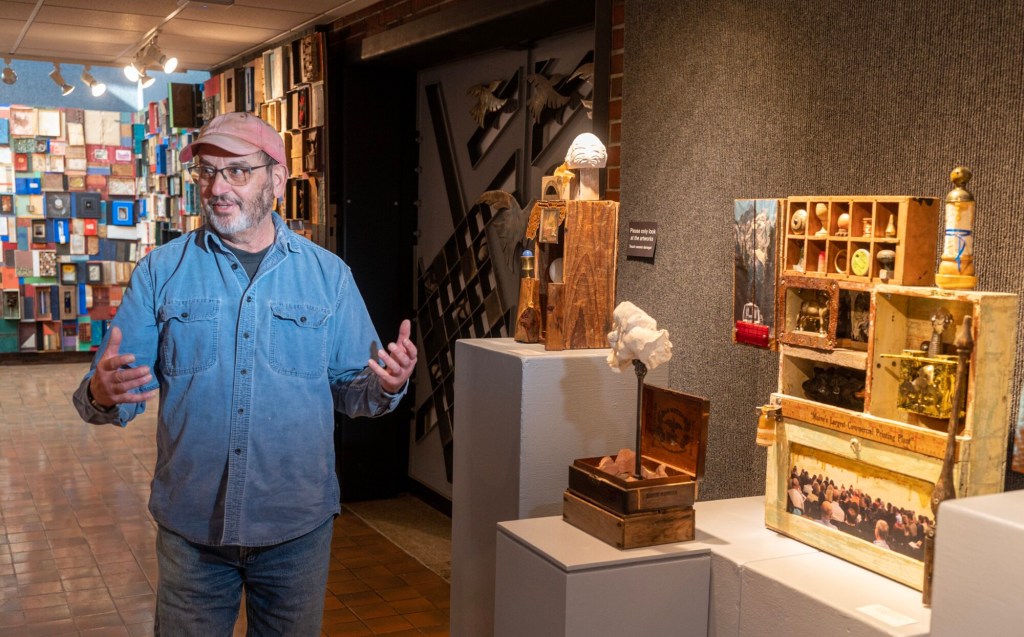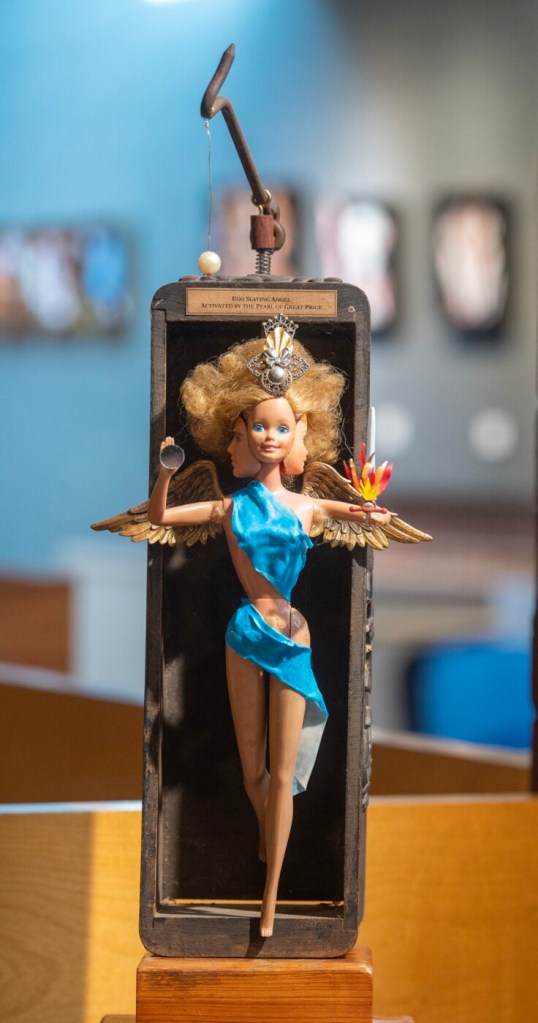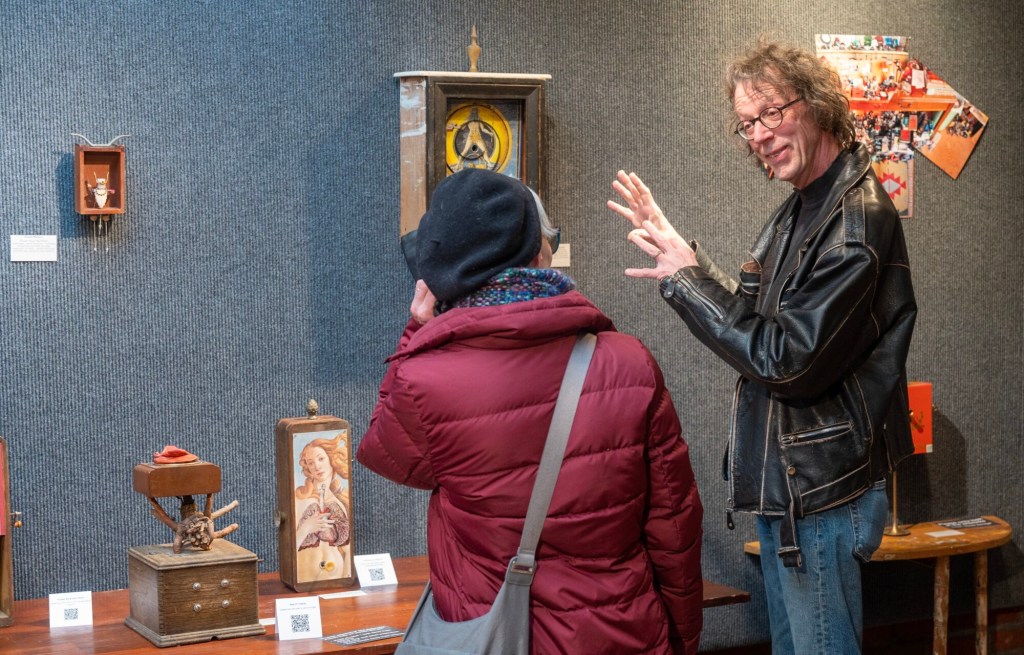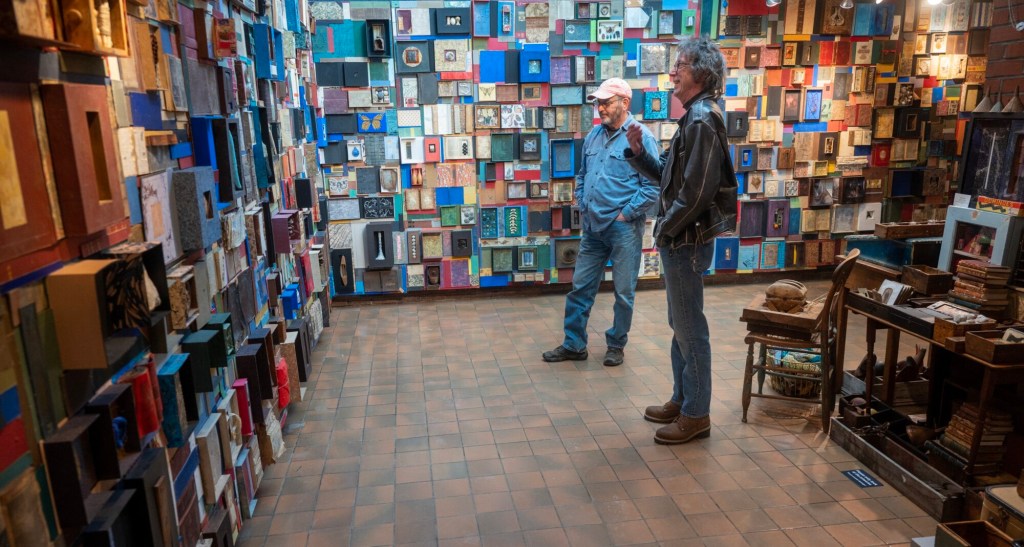AUGUSTA – Four Maine artists have discovered the divine within found objects, and their work will be on display at the University of Maine at Augusta’s Charles Danforth Gallery until March 8.

“The Art of Assemblage: Myth, Mystery, and Spirituality,” according to the gallery’s director, Amy Rahn, “pulls together the things of the world – plates, wires, cocktail glasses, watch dials, river stones, gears and springs – to consider the big questions that spirituality often addresses.”
Because of this, Rahn said the exhibit is immediately visually engaging, but the experience “becomes even richer and more interesting the longer you spend with the works in the show.”
The exhibit opened Jan. 23 and was organized by UMA Professor of Art Robert Katz, who is among the four featured artists. As part of the project, there will be a Zoom panel discussion open to the public on Feb. 22 at 6 p.m.
Assemblage art involves creating a piece by bringing found objects together. The objects would otherwise seem unrelated but, once brought together, they are recontextualized and unified.
“There’s a long tradition of assemblage art, not just in Maine, but in the art world,” said Katz.
Through being an artist and living in Maine for 40 years, Katz said it was easy to find people he wanted to invite to the show.
The other three artists are Abbie Read, who lives in Appleton, David Matson of Readfield and Sally Wagley of Brunswick.
The Danforth Gallery, located in Jewett Hall, typically features five to seven contemporary art exhibits each year. It is open weekdays from 9 a.m. to 5 p.m. from September through May, though Rahn hopes to eventually keep it open through the summer.

Artists Robert Katz, left, and David Matson look at Abbie Read’s large-scale work on display Tuesday in “The Art Of Assemblage: Myth, Mystery, And Spirituality” exhibit in the Charles Danforth Gallery at the University of Maine at Augusta. The piece, titled “Library,” is 40 feet long and 7 1/2 feet tall and was made over the course of five years. The exhibit runs through March 8. Joe Phelan/Kennebec Journal
Read, whose large-scale piece titled “Library,” is a part of the latest exhibit, said on Sunday that she’s been making art for her entire life.
“My mother was an artist and she taught us early on to be creative,” said Read. “She was my biggest inspiration, though I have had many inspiring art teachers since. What inspires any of us to make art? It is a calling.”
She began exhibiting her work in the 1980s and her work has since been featured in Maine and beyond. Read considers herself a mixed-media artist and said she often uses found objects in her work, but also does paintings, collages, prints and sculptural pieces.
“Library,” which is 40 feet long and 7 1/2 feet tall, was made over the course of five years.
She said the title reflects her choice of materials, which heavily features book pages among other found objects, all arranged like a collage. She said each individual part of the exhibit is embedded with unique stories, much like a library.
“If there is a spiritual aspect to my work, it is because I think one’s spirit is very much on display in one’s art,” she said.
Matson is a part-time Episcopal priest and a full-time artist. His website describes his work as “Found Object Esoterica.”
“When I became a priest, my prayer was that I may also be an artist,” Matson said. “At the time, priest and artist seemed to stand at opposing poles. I have since come to believe that priest and artist fundamentally do the same thing: in either case, one stands on a threshold between the worlds.”
Many of his works are interactive, such as the Hieros Gamos (Sacred Marriage) which is made of two frames and two opposite shapes that come together as one when a handle is used to rotate the piece.
Wagley works in multiple forms of media, ranging from drawings, stitches, text, collage and assemblage. Her work has been featured in venues in Maine and New Hampshire since 2012, and she has also hosted two solo shows.
Wagley said she “got hooked on looking at and making pictures at age 6,” during her first trip to a museum. She was particularly inspired by Renaissance paintings, which she described as “both weird and wonderful.”

Wendy Sawyer chats Tuesday with her cousin, artist David Matson of Readfield, about his corner of “The Art Of Assemblage: Myth, Mystery, And Spirituality” exhibit in the Charles Danforth Gallery at the University of Maine at Augusta. Joe Phelan/Kennebec Journal
Her exhibit includes shadow boxes inspired by stories from the Bible, the lives of saints and Greek mythology, all stories that inspired her at a young age.
“In this work, I attempt to make sense of those stories – such as the Old Testament account of the plagues, which certainly resonate in these times,” she said. “In my work the shadow box serves as a rudimentary stage for telling and interpreting these stories, recalling the dioramas we used to make in elementary school.”
Katz said his work in the exhibit tells the story of the five Books of Moses in the Jewish Torah, ending with the death of Moses.
“These are stories that I grew up with, and that my children grew up with,” he said. “They’ve always been a part of my life.”
Katz said he recently lost his father, who worked as a mechanic, and found several items that wound up in the exhibit as he was going through his things.

“Ego Slaying Angel, Activated by Pearl of Great Price” by Readfield artist David Matson is part of “The Art Of Assemblage: Myth, Mystery, And Spirituality” show in the Charles Danforth Gallery at the University of Maine at Augusta. Joe Phelan/Kennebec Journal
In his exhibit, items such as a trophy with a man extending his arm is parting the Red Sea and a toy pickup truck packed with blocks containing pictures of animals is the ark amid the great flood.
“There was, for me, on a very personal level, a nice connection between cleaning out my father’s workspace and being able to integrate a lot of his objects into the work of art as well,” he said.
The works were accompanied by an essay from Aaron Rosen, director of the Parsonage Gallery in Searsport. Rosen wrote that the show emphasizes Maine’s unique tradition of assemblage, and that showing the work of these four unique artists together could, in a certain light, be considered an act of assemblage.
“Despite such different spiritual journeys, the artists bring a similarly non-dogmatic, playful spirit to their works,” he wrote, “sparking numerous interreligious parallels and dialogues along the way. Whether tackling the prejudices of the canon, as Sally Wagley does, or delving into the overlapping acts of map and mythmaking, as Abbie Read does, the works in this exhibition invite responses as personal as the objects they bind together.”
Send questions/comments to the editors.








